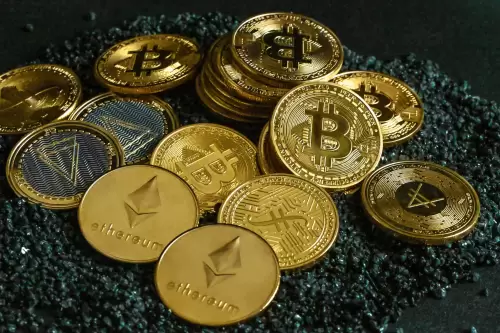 |
|
 |
|
 |
|
 |
|
 |
|
 |
|
 |
|
 |
|
 |
|
 |
|
 |
|
 |
|
 |
|
 |
|
 |
|
Cryptocurrency News Articles
The Dawn of Bitcoin Decentralized Finance (DeFi)
May 13, 2025 at 01:19 pm
Despite some setbacks, momentum is building around unlocking Bitcoin's potential beyond digital gold.

Decentralized finance (DeFi) on Bitcoin is no longer a pipe dream. Despite some setbacks, momentum is building to realize the potential of the orange coin beyond digital gold.
Of course, no one really cares, and for good reason. To be honest, it’s still a bit messy.
While Ethereum has managed to build a massive DeFi economy, with over $1.5 trillion in liquidity locked up in cold wallets, Bitcoin has lagged behind. The absence of DeFi smart contracts, the lack of a decentralized wrapper/bridge (wBTC), and Bitcoin’s status as digital gold limited the development of an ecosystem around the orange currency.
But things are changing.
As a wave of new protocols launch on and around Bitcoin, we’re seeing the foundations of a truly BTC-native DeFi stack emerge. These projects, such as Babylon, Lombard, SatLayer, and Solv Protocol, are leading the way in terms of technology and total value locked (TVL), each solving a different piece of the DeFi Lego.
Babylon: Bitcoin’s Collateral Layer
Perhaps best known for being the first native Bitcoin staking protocol, Babylon can be compared to Ethereum’s Beacon Chain, but designed specifically for Bitcoin. It has over $5 billion in TVL.
What’s special about Babylon is that it allows users to stake BTC directly on the Bitcoin mainnet, without the need for a bridge or wrapper. The coins remain where they are, stored in a non-custodial manner.
However, Babylon is not just about staking for the sake of staking. Its main innovation is to extend the security of Bitcoin to other blockchains, whether it is an EVM chain, a Rollup, or an application chain.
Bitcoin holders can now help secure the network and earn rewards from the chain they are securing by locking up their coins.
Lombard: Liquid Staking for Bitcoin
It’s the Lido of Bitcoin. Babylon does the staking; Lombard makes it composable.
As a result, Lombard, which has $1.9 billion in Bitcoin-related TVL, is built on Babylon. It allows users to stake BTC through Babylon and receive LBTC, a liquid staking token that represents the staked position.
In fact, as we said before, BTC staked through Babylon remain locked on the BTC network. Therefore, they are "useless" without the consensus mechanism to verify other networks. They cannot be used in DeFi. This is exactly where Lombard comes in. Now, users can get liquid staked BTC (LBTC) and start trading, lending, mining and all other similar things.
Lombard earns revenue by delegating BTC to Babylon validators, who in turn secure external networks and earn rewards, as mentioned earlier. These rewards are shared with LBTC holders. In simple terms, the more chains Babylon verifies, the higher the returns for stakers.
Lombard is active in multiple ecosystems including Sonic, Sui, and Base, and has demonstrated its composability by partnering with protocols such as Aave, Pendle, Ether.Fi, and Corn. It also played an important role in the Boyco Berachain liquidity event, helping to kick-start early TVL.
SatLayer: Bitcoin’s EigenLayer
As the title suggests, SatLayer can be thought of as an Eigen Layer built on top of Babylon.
Although its TVL is the smallest on the list at just $340 million, it introduces a new re-staking model. While Babylon locks BTC to secure external networks at the consensus layer, SatLayer allows users to re-stake LBTC to secure the application layer.
This opens the door to markets for yields derived directly from protected applications, for example, an oracle paying re-stakeholders to ensure data integrity, or a Rollup paying re-stakeholders to ensure transaction validity, or a bridge paying to avoid slashing or fraud.
SatLayer supports re-staking on the EVM and Sui networks.
Do you see the full picture now?
Are the similarities to Ethereum, Lido, and Eigen Layer beginning to emerge?
However, it is important to note that both Lombard and SatLayer currently depend on Babylon, but not vice versa.
SatLayer does not necessarily rely on Lombard, although given its decentralized nature, Lombard is currently the only solution it leverages.
Solv Protocol: BTC Reserves and DeFi Vaults
The Solv protocol, which has a TVL of $524.27 million in the BTC ecosystem, takes a different approach.
Similar to Lombard, it provides liquidity staking for BTC, but is not dependent on Babylon and focuses on building its own Bitcoin reserve strategy and other DeFi products.
In fact, the SolvBTC token is a liquid representation of its BTC reserve strategy. Users deposit a wrapped version of BTC, and then Solv converts most of it into native BTC through institutional channels and stores it through centralized custody.
While Solv is not dependent on Babylon, it benefits from Babylon-related assets such as LBTC.
Disclaimer:info@kdj.com
The information provided is not trading advice. kdj.com does not assume any responsibility for any investments made based on the information provided in this article. Cryptocurrencies are highly volatile and it is highly recommended that you invest with caution after thorough research!
If you believe that the content used on this website infringes your copyright, please contact us immediately (info@kdj.com) and we will delete it promptly.
-

- Real-world assets (RWAs) on the blockchain are like owning a chunk of a skyscraper or a shipping container without the paperwork nightmare.
- May 13, 2025 at 08:30 pm
- I got hooked after tossing $50 into a tokenized warehouse on Centrifuge, earning 6% like a digital tycoon, but I've also tripped over scams.
-

-

-

-

-

-

-

-






















![Bitcoin pulls back! Is the opportunity to get on the bus? Ether currency has made a fake breakthrough, and altcoins have plummeted! [It is recommended to watch at 1.5X times faster] Bitcoin pulls back! Is the opportunity to get on the bus? Ether currency has made a fake breakthrough, and altcoins have plummeted! [It is recommended to watch at 1.5X times faster]](/uploads/2025/05/13/cryptocurrencies-news/videos/bitcoin-pulls-opportunity-bus-ether-currency-fake-breakthrough-altcoins-plummeted-recommended-watch-x-times-faster/image_500_375.webp)




































